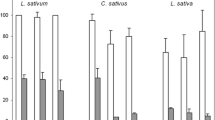Abstract
The fate of the explosive 2,4,6-TNT in plants is of major interest. Therefore, a method was developed to analyse TNT and derivatives in plant tissue. The method was utilized to investigate the uptake and metabolism of TNT inMedicago sativa andAllium schoenoprasum grown in hydroponic cultures containing TNT levels of 0.1 to 10 mg/1. Detectable concentrations of nitrotoluenes were significantly higher inAllium schoenoprasum than inMedicago sativa. The uptake of TNT in plants was directly related to the initial TNT level. The principal nitroaromatic components in roots and shoots of both plant species were identified as 4-ADNT and 2-ADNT in equal amounts, with substantially less TNT.
Similar content being viewed by others
Literature
Amerkhanova, N. N.;R. P. Naumova: 2,4,6-Trinitrotoluene as a source of nutrition for bacteria. Microbiology47, 318 (1978)
Broughton, W. J.;M. J. Dilworth: Control of leghaemoglobin in snake beans. Biochem. J. 125, 1075 (1971)
Cataldo, D. A.; S. D. Harvey; R. J. Fellows; R. M. Bean; B. D. McVeety: An evaluation of the environmental fate and behavior of munitions material (TNT, RDX) in soil and plant systems. Pacific Northwest laboratories, Richland, Report AD-A223 546 (1989)
Djerassi, L. S.;L. Vitany: Haemolytic episode in G6-PD deficient workers exposed to TNT. Brit. J. Ind. Med. 32, 54 (1975)
Folsom, B. L.; J. C. Pennington; S. L. Teeter; M. R. Barton; J. A. Bright: Effects of soil pH and treatment level on persistence and plant uptake of 2,4,6-trinitrotoluene. Waterways Experiment Station, Corps of Engineers, Vicksburg, MS, Technical Report EL-88-22(1988)
Grant, W. M.: Toxicology of the eye. Charles C. Thomas Publishers, Springfield Illinois 1986, p. 953
Hathaway, J. A.: Trinitrotoluene — a review of reported dose-related effects providing documentation for a workplace standard. J. Occupa. Med.19, 341 (1977)
Harvey, S. D.;R. J. Fellows;D. A. Cataldo;R. M. Bean: Analysis of 2,4,6-trinitrotoluene and its transformation products in soils and plant tissues by high-performance liquid chromatography. J. Chromato. 518, 361 (1990)
Koss, G.; A. Lommel; I. Ollroge; I. Tesseraux; R. Haas; A. D. Kappos: Zur Toxikologie der Nitrotoluole und weiterer Nitroaromaten aus rüstungsbedingten Altlasten. Bundesgesundhbl. 527 (1989)
Osmon, J. L.;R. E. Klausmeier: The microbial degradation of explosives. Dev. Ind. Microbiol.14, 247 (1972)
Palazzo, A. J.;D. C. Leggett: Effect and disposition of TNT in a terrestrial plant. J. Environ. Quail.15, 49 (1986)
Pennington, J. C.: Plant uptake of 2,4,6-trinitrotoluene, 4-amino-2,6-dinitrotoluene, and 2-amino-4,6-dinitrotoluene using 14C-labeled and unlabeled compounds. US Army Engineer Waterways Experiment Station, Miss Vicksburg: Technical Report EL-88-20th (1988)
Preuss, A.;J. Fimpel;G. Diekert: Anaerobic transformation of 2,4,6-trinitrotoluene (TNT). Arch. Microbiol.159, 345 (1993)
SAS Institute: SAS/STAT Guide for Personal Computers, Version 6.03 Edition 1988
Schott, C. D; E. G. Worthley: The toxicity of TNT and related wastes to an aquatic flowering plant,Lemna perpusilla. Edgewood Arsenal, Aberdeen Prov. Ground, MD. Techn. report 74016. AD-778158 (1974)
Smock, L. A.;D. L. Stoneburger;J. R. Clark: The toxic effects of trinitrotoluene (TNT) and its primary degradation products on two species of algae and the fathead minnow. Water Res10, 537 (1976)
Spanggord, R. J.;T. Mill;T.-W. Chou;W. R. Maybe;J. H. Smith;S. Lee: Environmental fate studies on certain munition wastewater constituents. Final report. Phase II, Laboratory studies, SRI International, Menlo Park. CA (1980)
Tucker, W. L.; W. L. Banwart; T. C. Granato; J. J. Hassett: Screening for plant tolerance to TNT. Report for USATHAMA by CERL and the University of Illinois (1989)
V. Löw, E.;L. Kaminski;W. Neumeier;R. Haas;K. Steinbach: Mikrobieller Abbau von Nitroaromaten aus einer ehemaligen Sprengstoffproduktion. Forum Städte-Hygiene40, 347 (1989)
Whipps, J. M.: Carbon economy. In:J. M. Lynch, The rhizosphere. John Wiley & Sons, Chichester 1990, pp. 59
Author information
Authors and Affiliations
Rights and permissions
About this article
Cite this article
Görge, E., Brandt, S. & Werner, D. Uptake and metabolism of 2,4,6-trinitrotoluene in higher plants. Environ Sci & Pollut Res 1, 229–233 (1994). https://doi.org/10.1007/BF02986535
Received:
Accepted:
Issue Date:
DOI: https://doi.org/10.1007/BF02986535




